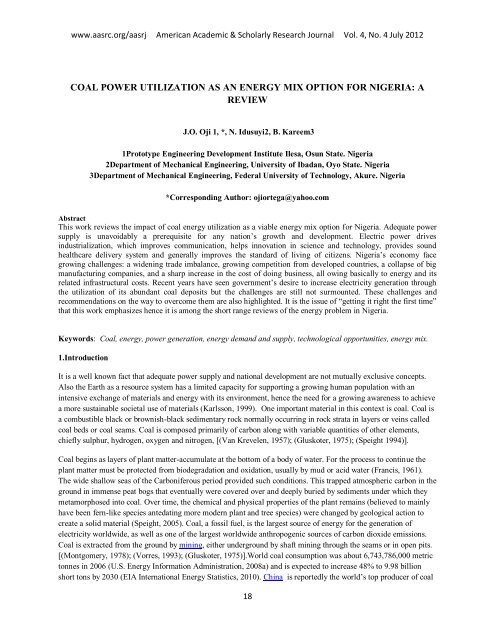E - American Academic & Scholarly Research Center
E - American Academic & Scholarly Research Center
E - American Academic & Scholarly Research Center
You also want an ePaper? Increase the reach of your titles
YUMPU automatically turns print PDFs into web optimized ePapers that Google loves.
www.aasrc.org/aasrj <strong>American</strong> <strong>Academic</strong> & <strong>Scholarly</strong> <strong>Research</strong> Journal Vol. 4, No. 4 July 2012<br />
COAL POWER UTILIZATION AS AN ENERGY MIX OPTION FOR NIGERIA: A<br />
REVIEW<br />
J.O. Oji 1, *, N. Idusuyi2, B. Kareem3<br />
1Prototype Engineering Development Institute Ilesa, Osun State. Nigeria<br />
2Department of Mechanical Engineering, University of Ibadan, Oyo State. Nigeria<br />
3Department of Mechanical Engineering, Federal University of Technology, Akure. Nigeria<br />
*Corresponding Author: ojiortega@yahoo.com<br />
Abstract<br />
This work reviews the impact of coal energy utilization as a viable energy mix option for Nigeria. Adequate power<br />
supply is unavoidably a prerequisite for any nation’s growth and development. Electric power drives<br />
industrialization, which improves communication, helps innovation in science and technology, provides sound<br />
healthcare delivery system and generally improves the standard of living of citi ens. Nigeria’s economy face<br />
growing challenges: a widening trade imbalance, growing competition from developed countries, a collapse of big<br />
manufacturing companies, and a sharp increase in the cost of doing business, all owing basically to energy and its<br />
related infrastructural costs. Recent years have seen government’s desire to increase electricity generation through<br />
the utilization of its abundant coal deposits but the challenges are still not surmounted. These challenges and<br />
recommendations on the way to overcome them are also highlighted. It is the issue of “getting it right the first time”<br />
that this work emphasizes hence it is among the short range reviews of the energy problem in Nigeria.<br />
Keywords: Coal, energy, power generation, energy demand and supply, technological opportunities, energy mix.<br />
1.Introduction<br />
It is a well known fact that adequate power supply and national development are not mutually exclusive concepts.<br />
Also the Earth as a resource system has a limited capacity for supporting a growing human population with an<br />
intensive exchange of materials and energy with its environment, hence the need for a growing awareness to achieve<br />
a more sustainable societal use of materials (Karlsson, 1999). One important material in this context is coal. Coal is<br />
a combustible black or brownish-black sedimentary rock normally occurring in rock strata in layers or veins called<br />
coal beds or coal seams. Coal is composed primarily of carbon along with variable quantities of other elements,<br />
chiefly sulphur, hydrogen, oxygen and nitrogen, [(Van Krevelen, 1957); (Gluskoter, 1975); (Speight 1994)].<br />
Coal begins as layers of plant matter-accumulate at the bottom of a body of water. For the process to continue the<br />
plant matter must be protected from biodegradation and oxidation, usually by mud or acid water (Francis, 1961).<br />
The wide shallow seas of the Carboniferous period provided such conditions. This trapped atmospheric carbon in the<br />
ground in immense peat bogs that eventually were covered over and deeply buried by sediments under which they<br />
metamorphosed into coal. Over time, the chemical and physical properties of the plant remains (believed to mainly<br />
have been fern-like species antedating more modern plant and tree species) were changed by geological action to<br />
create a solid material (Speight, 2005). Coal, a fossil fuel, is the largest source of energy for the generation of<br />
electricity worldwide, as well as one of the largest worldwide anthropogenic sources of carbon dioxide emissions.<br />
Coal is extracted from the ground by mining, either underground by shaft mining through the seams or in open pits.<br />
[(Montgomery, 1978); (Vorres, 1993); (Gluskoter, 1975)].World coal consumption was about 6,743,786,000 metric<br />
tonnes in 2006 (U.S. Energy Information Administration, 2008a) and is expected to increase 48% to 9.98 billion<br />
short tons by 2030 (EIA International Energy Statistics, 2010). China is reportedly the world’s top producer of coal<br />
18


